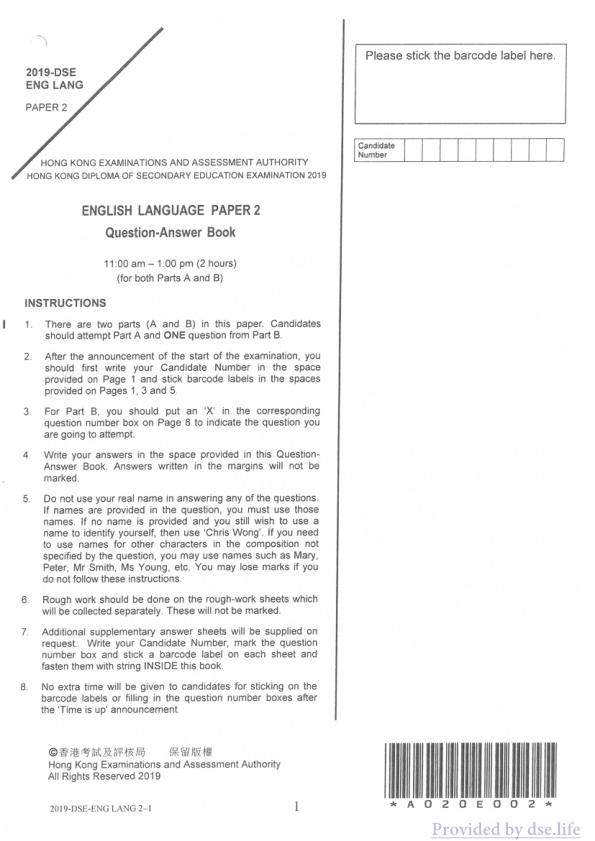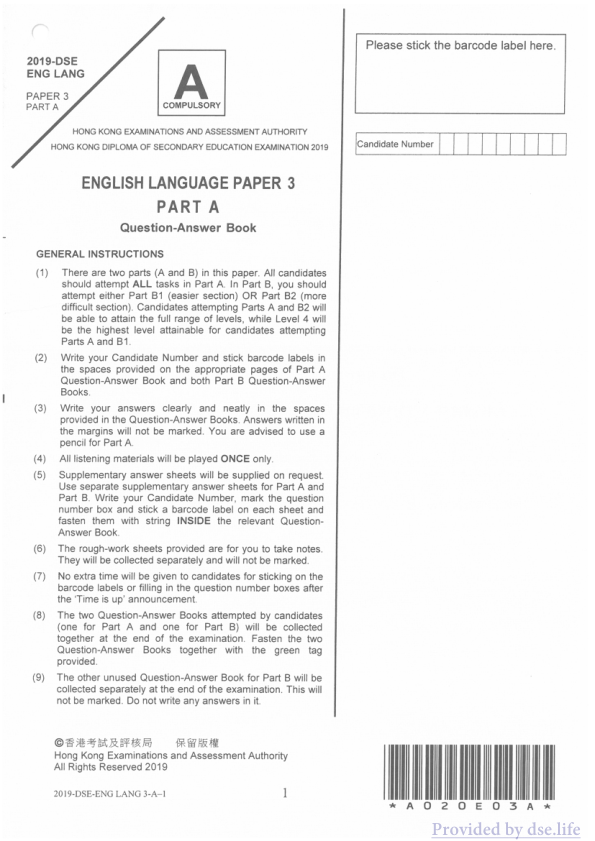2019 DSE 英国语文-English 真题 答案 详解
2019-05-10 dse dse 英国语文-English
| 序号 | 文件列表 | 说明 | ||
|---|---|---|---|---|
| 1 | 2019-英国语文-English-answer.pdf | 27 页 | 953.89KB | 答案 |
| 2 | 2019-英国语文-English-paper1.pdf | 28 页 | 19.20MB | 真题 Paper 1 |
| 3 | 2019-英国语文-English-paper2.pdf | 12 页 | 7.70MB | 真题 Paper 2 |
| 4 | 2019-英国语文-English-paper3.pdf | 48 页 | 27.23MB | 真题 Paper 3 |
| 5 | 2019-英国语文-English-paper4.pdf | 24 页 | 982.04KB | 真题 Paper 4 |
答案
Marking Schemes
This document was prepared for markers' reference. It should not be regarded as a set of model answers. Candidates and teachers who were not involved in the marking process are advised to interpret its content with care.
Paper 1 (Reading)
Part A (compulsory section) 1. i) False [62] ii) True [92] iii) False [90] iv) Not Given [82] v) True [67]
-
(this) tangle of commitment [34]
-
C [59]
4. i) ✓ [20] ii) can cannot // can't [48] iii) calm anxious // nervous [74] iv) hate prefer // like [23] v) messy tidy // neat // well-organised // well-organized [43] vi) easy hard // difficult are aren't - [37]
-
(a / the title / name (of Tim's / Harford's / his book)) // (a / the / his / Tim's / Harford's) book ('s name) [39]
-
archives [32]
-
piling up (of paper (on your / their desk)) // being messy [28]
8. i) organised // organized // self-organising // self-organizing [58] ii) random [69] iii) bottom [64] iv) list [55] v) clear [56]
9. i) highly // incredibly [61] ii) dysfunctional [54] iii) fine [39] iv) psychologically [63] v) done [48]
-
B [46]
-
(carried a lot of) baggage (around) [27]
-
be aesthetically pleasing // neat / tidy / clean // work like operating theatre(s) / high functioning (precision engineering) production lines // be (highly) functional / productive / effective / efficient / organized [42]
-
(our / people's / effective) organizational / organisational systems [62]
-
D [48]

真题 Paper 1
2019-DSE ENG LANG PAPER 1 PART A
HONG KONG EXAMINATIONS AND ASSESSMENT AUTHORITY HONG KONG DIPLOMA OF SECONDARY EDUCATION EXAMINATION 2019
A ENGLISH LANGUAGE PAPER 1 PART A Reading Passages 8:30 am - 10:00 am (1½ hours) (for both Parts A and B)
GENERAL INSTRUCTIONS
(1) There are two parts (A and B) in this paper. All candidates should attempt Part A. In Part B, you should attempt either Part B1 (easier section) OR Part B2 (more difficult section). Candidates attempting Parts A and B will be able to attain the full range of levels, while Level 4 will be the highest level attainable for candidates attempting Parts A and B1.
(2) After the announcement of the start of the examination, you should first write your Candidate Number and stick barcode labels in the spaces provided on the appropriate pages of the Part A Question-Answer Book and the Part B Question-Answer Book which you are going to attempt.
(3) Write your answers in the spaces provided in the Question-Answer Books. Answers written in the margins will not be marked.
(4) For multiple-choice questions, you are advised to blacken the appropriate circle with a pencil so that wrong marks can be completely erased with a clean rubber. Mark only ONE answer to each question. Two or more answers will score NO MARKS.
(5) Supplementary answer sheets will be supplied on request. Use separate supplementary answer sheets for Part A and Part B. Write your Candidate Number, mark the question number box and stick a barcode label on each sheet, and fasten them with string INSIDE the relevant Question-Answer Book.
(6) No extra time will be given to candidates for sticking on barcode labels or filling in the question number boxes after the 'Time is up' announcement.
(7) The two Question-Answer Books you have attempted (one for Part A and one for Part B) will be collected together at the end of the examination. Fasten the two Question-Answer Books together with the green tag provided.
(8) The unused Question-Answer Book for Part B will be collected separately at the end of the examination. This will not be marked. Do not write any answers in it.
INSTRUCTIONS FOR PART A
(1) The Question-Answer Book for Part A is inserted in this Reading Passages booklet.
(2) Attempt ALL questions in Part A. Each question carries ONE mark unless otherwise stated.
© 香港考試及評核局保留版權 Hong Kong Examinations and Assessment Authority All Rights Reserved 2019
Not to be taken away before the end of the examination session
2019-DSE-ENG LANG 1-A-RP-1
Provided by dse.life

真题 Paper 2
2019-DSE ENG LANG PAPER 2
HONG KONG EXAMINATIONS AND ASSESSMENT AUTHORITY HONG KONG DIPLOMA OF SECONDARY EDUCATION EXAMINATION 2019
ENGLISH LANGUAGE PAPER 2 Question-Answer Book
11:00 am - 1:00 pm (2 hours) (for both Parts A and B)
INSTRUCTIONS
-
There are two parts (A and B) in this paper. Candidates should attempt Part A and ONE question from Part B.
-
After the announcement of the start of the examination, you should first write your Candidate Number in the space provided on Page 1 and stick barcode labels in the spaces provided on Pages 1, 3 and 5.
-
For Part B, you should put an 'X' in the corresponding question number box on Page 8 to indicate the question you are going to attempt.
-
Write your answers in the space provided in this Question-Answer Book. Answers written in the margins will not be marked.
-
Do not use your real name in answering any of the questions. If names are provided in the question, you must use those names. If no name is provided and you still wish to use a name to identify yourself, then use ‘Chris Wong’. If you need to use names for other characters in the composition not specified by the question, you may use names such as Mary, Peter, Mr Smith, Ms Young, etc. You may lose marks if you do not follow these instructions.
-
Rough work should be done on the rough-work sheets which will be collected separately. These will not be marked.
-
Additional supplementary answer sheets will be supplied on request. Write your Candidate Number, mark the question number box and stick a barcode label on each sheet and fasten them with string INSIDE this book.
-
No extra time will be given to candidates for sticking on the barcode labels or filling in the question number boxes after the ‘Time is up’ announcement.
© 香港考試及評核局保留版權 Hong Kong Examinations and Assessment Authority All Rights Reserved 2019
2019-DSE-ENG LANG 2-1
Please stick the barcode label here.
Candidate Number
AO20E002
Provided by dse.life

真题 Paper 3
2019-DSE ENG LANG PAPER 3 PART A
A COMPULSORY
HONG KONG EXAMINATIONS AND ASSESSMENT AUTHORITY HONG KONG DIPLOMA OF SECONDARY EDUCATION EXAMINATION 2019
ENGLISH LANGUAGE PAPER 3 PART A Question-Answer Book
GENERAL INSTRUCTIONS
(1) There are two parts (A and B) in this paper. All candidates should attempt ALL tasks in Part A. In Part B, you should attempt either Part B1 (easier section) OR Part B2 (more difficult section). Candidates attempting Parts A and B2 will be able to attain the full range of levels, while Level 4 will be the highest level attainable for candidates attempting Parts A and B1.
(2) Write your Candidate Number and stick barcode labels in the spaces provided on the appropriate pages of Part A Question-Answer Book and both Part B Question-Answer Books.
(3) Write your answers clearly and neatly in the spaces provided in the Question-Answer Books. Answers written in the margins will not be marked. You are advised to use a pencil for Part A.
(4) All listening materials will be played ONCE only.
(5) Supplementary answer sheets will be supplied on request. Use separate supplementary answer sheets for Part A and Part B. Write your Candidate Number, mark the question number box and stick a barcode label on each sheet and fasten them with string INSIDE the relevant Question-Answer Book.
(6) The rough-work sheets provided are for you to take notes. They will be collected separately and will not be marked.
(7) No extra time will be given to candidates for sticking on the barcode labels or filling in the question number boxes after the 'Time is up' announcement.
(8) The two Question-Answer Books attempted by candidates (one for Part A and one for Part B) will be collected together at the end of the examination. Fasten the two Question-Answer Books together with the green tag provided.
(9) The other unused Question-Answer Book for Part B will be collected separately at the end of the examination. This will not be marked. Do not write any answers in it.
© Hong Kong Examinations and Assessment Authority All Rights Reserved 2019
2019-DSE-ENG LANG 3-A-1
Please stick the barcode label here.
Candidate Number
AO20E03A
Provided by dse.life

真题 Paper 4
2019-DSE ENG LANG PAPER 4 1.1 EXAMINER HONG KONG EXAMINATIONS AND ASSESSMENT AUTHORITY HONG KONG DIPLOMA OF SECONDARY EDUCATION EXAMINATION 2019 ENGLISH LANGUAGE PAPER 4 PART A Group Interaction This article appeared in a local newspaper: Redevelopment in Western District leaves residents without a good night’s sleep. “Redevelopment of old areas gives opportunities for developers to earn money. But local people do not have any say in the redevelopment and are forced to leave.” If you took a walk around Western District just a couple of years ago, you would see mostly stationary shops, bakeries, grocers and university students eating in cha chaan tengs. For years, even with its proximity to Central, the old neighbourhood remained largely untouched, retaining its traditional characteristics and flavour. But when three new MTR stations — Sai Ying Pun, HKU and Kennedy Town — opened in the area in late 2014, they brought with them a whole range of bars and expensive restaurants that drew in young rich hipsters. Today, Western District is the new, trendy neighbourhood, with young professionals increasingly turning older buildings into expensive trendy flats, forcing many long-term residents to leave the area that has been their home all their lives. Traditional shops are forced to leave because of high rents: 250 of the 700 shops in the Sai Ying Pun area either changed tenants or closed down from 2015 to 2017. There have been multiple complaints from residents about noise from bars and restaurants. “For families and the elderly in this area, they are disturbed by the noise every day and can’t afford to shop,” one netizen said. “We can’t stop the world from developing, but there has to be a balance.” Your class is discussing the redevelopment of older districts in Hong Kong. Your group has been asked to discuss the problems redevelopment causes. You may want to talk about: why old districts are redeveloped what problems redevelopments cause what the government should do to reduce the problems residents face anything else you think is important PART B Individual Response 1. What do you like about the area you live in? 2. What is the biggest advantage of redevelopment? 3. What types of shops are typical of old neighbourhoods? 4. Why do older people like to live in traditional districts? 5. What would you like to change about your district? 6. Would you prefer to live in an old neighbourhood or a redeveloped area? 7. Is the redevelopment of old areas too slow in Hong Kong? 8. Who benefits most from redevelopment? 93 DO NOT TAKE AWAY Provided by dse.life

